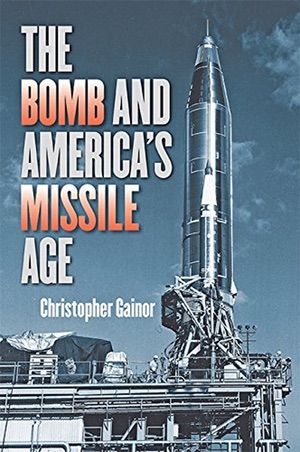Review: The Bomb and America’s Missile Ageby Jeff Foust
|
| Development of long-range missiles was stymied by several factors, from steep cuts in military spending to internecine battles among the Army, Navy, and newly independent Air Force about who would be responsible for missile development. |
One might think that those missiles were developed as part of long-term strategic plans by both countries, advancing the German rocket technology captured at the end of World War II and shaped by the development of nuclear weapons. However, as Canadian historian Christopher Gainor describes in The Bomb and America’s Missile Age, the development of long-range ballistic missiles, for launching weapons or satellites, was a more complex, confused process in the years after the war.
In the years immediately after World War II, the US did have access to a cache of captured V-2 rockets that were launched from White Sands, New Mexico, as well as Wernher von Braun and his team of rocket engineers. But development of long-range missiles was stymied by several factors, from steep cuts in military spending to internecine battles among the Army, Navy, and newly independent Air Force about who would be responsible for missile development. There was also skepticism that long-range ballistic missiles could even be developed in the foreseeable future, and competition from alternative technologies like ramjets, which at the time seemed more feasible than large rocket engines.
There was, though, some progress in rocketry in the late 1940s. Convair won a contract from the then-US Army Air Forces in early 1946 to study concepts for long-range missiles under Project MX-774. The Air Force cancelled the project in mid-1947, but allowed Convair to use its remaining funds to complete and launch three rockets. All three fell well short of a planned altitude of 160 kilometers, but Convair took the lessons learned from it and advanced them with paper studies after the end of MX-774.
The Soviet testing of the atomic bomb, the start of the Korean War, and resulting increase in defense spending helped to restart interest in long-range missiles. (Development of surface-to-air missiles that made bombers vulnerable also contributed.) The Air Force restarted a project with Convair, MX-1593, for a ballistic missile called Atlas, but with only modest support at first.
Gainor argues that the key development that accelerated work on ICBMs was the hydrogen bomb, which could weigh less than existing fission bombs but with far greater explosive yield. That enabled ICBMs to be smaller than originally envisioned and with less accuracy, overcoming the technical objections to them, and the Air Force proceeded with full-scale development of the Atlas in 1954.
| The Air Force had long relied on private contractors to develop its aircraft, an approach it continued with missiles, while the Army preferred its in-house arsenal approach to weapons development. |
The book is primarily about the American development of ICBMs, but Gainor does offer some insights into the Soviet missile program. As it turns out, Soviet leadership approved development of the R-7 just a few weeks after the Atlas got the go-ahead in the US in 1954. The vehicle was built to accommodate a hydrogen bomb based on calculations by Andrei Sakharov that such a device would weigh five to six tons—calculations that turned out to be wrong. The Atlas, by contrast, was being designed to carry nuclear warheads weighing just one ton.
One interesting insight in the book is the difference in approaches that the US Air Force and the Army took in missile development. The Air Force had long relied on private contractors to develop its aircraft, an approach it continued with missiles, while the Army preferred its in-house arsenal approach to weapons development. The Air Force treated missiles like aircraft, needing to be lightweight and streamlined, while the Army treated missiles more like artillery, with an emphasis on durability. This explains the development of the Atlas by Convair, with fuel tanks so thin they required pressurization in order to not collapse. The Army took a more conservative approach with its missile development, which von Braun would continue while at NASA.
As ICBMs, neither the Atlas nor the R-7 had long careers, replaced by improved missiles, particularly solid-fueled ones that were easier to handle and could be launched on a moment’s notice. Both, though, were influential space launch systems for decades, which Gainor examines in a brief chapter at the end of the book. He notes that “the space race of the twentieth century may not has been as inevitable as it looked at the time” had not those vehicles been developed as missiles.
The end may be in sight, though, for both vehicles. The Soyuz rocket, the descendant of the R-7, remains in service today, but its long-term future is unclear as Russia considers a number of different concepts for new launch systems, some of which may retain the Soyuz name but the not the vehicle’s characteristic design. The Atlas flying today shares little more than its name with the original ICBM and space launch vehicle—the Atlas 5 is, after all, powered by a Russian engine!—but is set to be retired in the 2020s after United Launch Alliance brings the new Vulcan rocket into service. An era started in the early years of the Cold War will finally come to a close.
Note: we are temporarily moderating all comments subcommitted to deal with a surge in spam.
